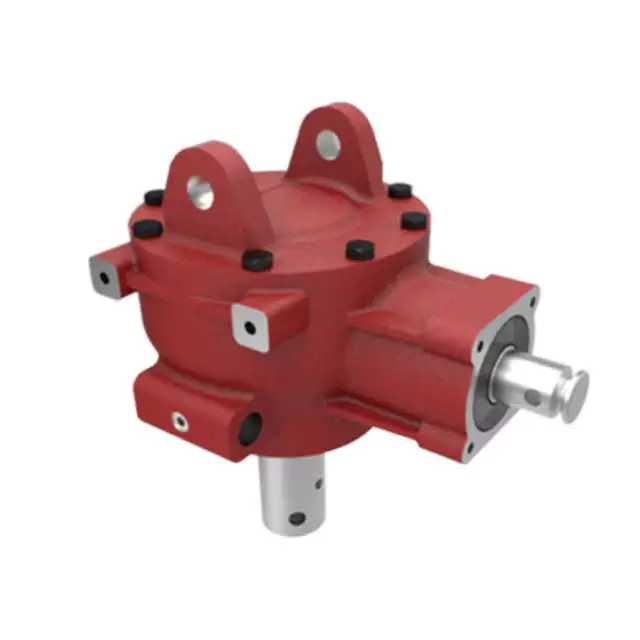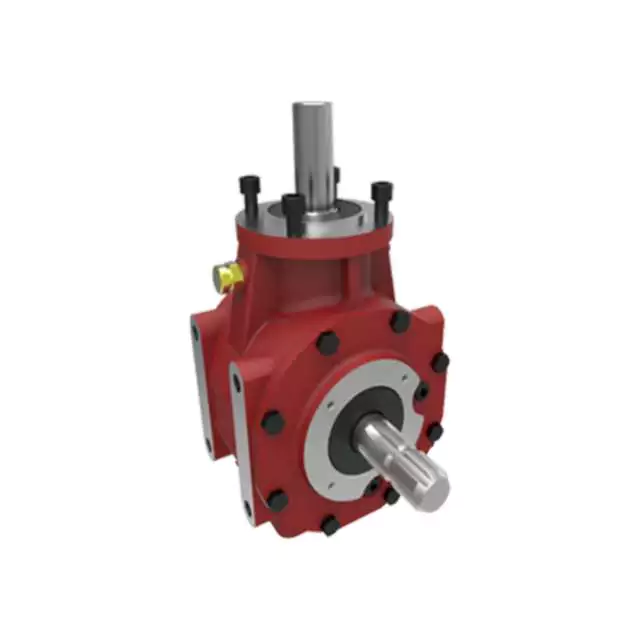Product Description
EP-MDH-40 Agricultural gearbox Lawn mower series
Characteristic
What gearbox is right for your lawn mower? There are 4 different types: hydrostatic transmission, manual transmission, and trans-axle. Let’s explore each in detail. What are the advantages and disadvantages of each type of gearbox? Which 1 will best suit your needs? Read on to find out! Besides the engine type, other important factors to consider include the transmission type,hydraulic or manual, and the number of horsepower.
Hydrostatic transmission
A hydrostatic transmission in a lawn mower gearbox is similar to an automatic transmission, except that instead of manual shifts,fluid is used to drive the blades. This type of transmission is also prone to frequent wear and tear, making it more expensive to repair. Hydrostatic transmissions also tend to consume more fuel than manual transmissions, making them less energy-efficient.Regardless of whether a lawn mower uses a hydrostatic or manual transmission, it is important to understand how these systems work.
A hydrostatic mower’s hydraulic system replaces the belts and gears. The fluid transfers force through the gears and reduces friction. This system has a smooth gear-change and increases the lifespan of the mower. Some common problems with hydrostatic mowers include leakage in the hydraulic pump, resulting in reduced power and a weaker response time when shifting gears. Another potential problem is misadjustment of the transmission control arm. If this happens, the wheels may start moving while they are still in neutral. Additionally, the shift control arm may not respond to manual movements.
Manual transmission
A lawn mower’s transmission is the most basic component. It determines the speed of the machine and how well it handles different backyard conditions. Manual transmissions typically come with a set number of speeds, like a car. While manual transmissions are difficult to operate, they can be particularly useful for users who are used to using gear sticks and don’t want to rely on a pedal for speed control. The following are some important factors to consider when buying a lawn mower.First, you should consider what type of terrain you will be mowing. Is it sloped, rocky, or slippery? This can affect the transmission type you choose. Make sure it has a clutch for smoother riding. Another consideration is how often you will be mowing your lawn. For example, you might only mow the lawn once a week, or only every other time you mow the entire lawn. In that case,you should opt for a manual transmission.
Trans-axle
A basic walk behind lawn mower transmission will only have 1 gear, while a more sophisticated model may have several gears and a variable slip differential. The trans-axle is what holds the wheels of the mower, supports the weight of the entire machine, and secures the drive assembly to the mower’s frame. The trans-axle consists of oily parts, including the driveshafts and differential.
Hydrostatic transmissions allow for better speed control and are usually the most expensive. However, they are less efficient than other types of transmissions, and will require more horsepower for the same size mower. This is a tradeoff you must make. Make sure you’re comfortable with the amount of power your mower needs and how much fuel it’ll use. If you need an automatic mower,you’ll want to avoid a hydrostatic transmission.
Locking differential
In order to unlock the locking differential on a lawn mower, you must first stop the mower and push the button on the rear
differential to the “Off” position. Some models come with foot pedals to operate the differential lock. Locking a lawn mower’s differential is an easy process, but there are some things to consider before attempting it. Here are some tips for locating the locking differential button. If the button is located in an awkward place, you might need to consult your owner’s manual.The locking differential allows both wheels to rotate at the same speed, which is helpful when mowing on sloping terrain. Using the differential lock will transfer maximum power to the remaining wheels, so you can continue in the direction you want to travel. If you don’t need the locking differential, you should purchase a different model with a different gear ratio. However,you shouldn’t try to repair this part yourself unless you are familiar with welding and other complicated processes.
Company Information
/* January 22, 2571 19:08:37 */!function(){function s(e,r){var a,o={};try{e&&e.split(“,”).forEach(function(e,t){e&&(a=e.match(/(.*?):(.*)$/))&&1
| Type: | Agricultural |
|---|---|
| Usage: | Agricultural Products Processing, Farmland Infrastructure, Tillage, Harvester, Planting and Fertilization, Grain Threshing, Cleaning and Drying |
| Material: | Iron |
| Power Source: | Electricity |
| Weight: | 45kg |
| After-sales Service: | Installation Guide 3-Year Warranty |

Contribution of Agricultural Gearboxes to Farming Machinery Versatility
Agricultural gearboxes play a pivotal role in enhancing the overall versatility of farming machinery. Here’s how they contribute:
- Variable Speeds: Agricultural gearboxes enable machinery to operate at different speeds, allowing farmers to adapt to various tasks. For instance, tractors equipped with adjustable gearboxes can efficiently switch between plowing, seeding, and harvesting.
- Torque Management: Gearboxes control torque delivery to match the requirements of different operations. This ensures optimal power transmission and prevents overloading during tasks like tilling or lifting heavy loads.
- Multi-Functionality: Many farming machines are designed to perform multiple tasks. By incorporating versatile gearboxes, these machines can efficiently switch between functions without requiring major modifications.
- Attachment Compatibility: Farm machinery often requires attachments like mowers, plows, or sprayers. Agricultural gearboxes can be designed to accommodate various attachments, increasing the machinery’s utility and adaptability.
- Adjustable Ratios: Some gearboxes allow operators to change gear ratios on-the-fly. This adaptability is essential for tasks that demand precise control over speed and torque, such as precision planting or spraying.
- Efficient Power Distribution: Gearboxes help distribute power from the engine to different components of the machinery, such as wheels, axles, and implements. This efficient power distribution ensures effective utilization of energy.
- Task-Specific Optimization: Different farming tasks have specific requirements. Agricultural gearboxes can be tailored to optimize machinery performance for tasks ranging from soil preparation to crop maintenance.
- Enhanced Maneuverability: Gearboxes can enable machinery to change directions easily and navigate tight spaces. This is especially valuable in tasks like plowing fields or maneuvering within orchards.
- Adapting to Terrain: Versatile gearboxes allow machines to adapt to different terrains, ensuring consistent performance on various surfaces like hills, slopes, or uneven ground.
- Seasonal Flexibility: Farming involves seasonal tasks that vary in demand and complexity. Gearboxes offer the flexibility to optimize machinery for specific tasks during different seasons, enhancing overall efficiency.
Agricultural gearboxes are a cornerstone of farming machinery versatility, enabling farmers to accomplish a wide range of tasks efficiently and effectively.

Handling Varying Torque Demands with Agricultural Gearboxes
Agricultural gearboxes are designed to handle the varying torque demands associated with different tasks in farming operations. The torque requirements can vary based on factors such as the type of task, the soil conditions, the terrain, and the machinery’s speed. Agricultural gearboxes are equipped with features that allow them to adapt to these varying torque demands:
- Gear Ratio Selection: Agricultural gearboxes often come with multiple gear ratios, allowing operators to select the appropriate ratio for the task at hand. Lower gear ratios provide higher torque for tasks that require more force, such as plowing or tilling, while higher gear ratios offer higher speeds for tasks like mowing or transporting.
- Torque Multiplier: Some agricultural gearboxes are designed with torque multipliers that enhance the torque output from the engine to the wheels or implement. These multipliers are engaged when higher torque is needed, helping the machinery handle heavy loads or challenging terrain.
- Adjustable Speeds: Many agricultural gearboxes allow operators to adjust the speed of the machinery to match the torque requirements of the task. This flexibility is essential for tasks that involve both high-torque, low-speed operations and high-speed operations with lower torque needs.
- Power Take-Off (PTO) Options: Agricultural gearboxes often feature power take-off mechanisms that enable the transfer of power from the engine to attached implements. These mechanisms can be designed to provide varying torque outputs to suit different implements, such as rotary tillers, balers, or pumps.
The ability of agricultural gearboxes to handle varying torque demands is crucial for ensuring efficient and effective farming operations. By offering adjustable gear ratios, torque multipliers, and adaptable speeds, these gearboxes empower farmers to optimize their machinery’s performance based on the specific requirements of each task.

Power Transmission in Farming Equipment with Agricultural Gearboxes
Agricultural gearboxes play a vital role in facilitating power transmission within various types of farming equipment. These gearboxes are integral components that enable the transfer of rotational power from a tractor’s engine to different agricultural implements and machinery. Here’s how agricultural gearboxes contribute to power transmission:
- Speed Reduction: In many farming operations, the engine of a tractor or other power source operates at a higher speed than is suitable for the optimal functioning of agricultural implements. Agricultural gearboxes provide speed reduction by using a combination of gears with different numbers of teeth. This reduction in speed allows the machinery to operate at the required speed for efficient tasks like tilling, planting, or harvesting.
- Power Multiplication: Some agricultural tasks require a significant amount of torque to operate effectively. Gearboxes can multiply the input torque from the engine to generate higher torque at the output shaft. This is crucial for tasks such as plowing, where substantial force is needed to break up the soil.
- Directional Change: Agricultural gearboxes also allow for changes in the direction of power transmission. For instance, a tractor’s power take-off (PTO) shaft may need to transmit power at a right angle to the tractor’s engine. Gearboxes with bevel gears or other arrangements enable this change in direction, ensuring that power is properly directed to the implement.
- Power Distribution: In certain cases, power needs to be distributed to multiple components or implements. Agricultural gearboxes with multiple output shafts can distribute power to different tasks simultaneously, optimizing efficiency and productivity.
- Attachment Operation: Many agricultural implements, such as plows, seed drills, and rotary mowers, require consistent and controlled power to function effectively. Gearboxes provide the necessary power and control to these attachments, ensuring uniform operation and accurate results.
By facilitating speed reduction, power multiplication, directional changes, power distribution, and attachment operation, agricultural gearboxes contribute significantly to the overall efficiency and productivity of farming equipment. They allow farmers to adapt their machinery to various tasks, optimize power usage, and achieve better results in different agricultural operations.


editor by CX 2024-03-28
by
Leave a Reply